жӮЁеҘҪпјҢзҷ»еҪ•еҗҺжүҚиғҪдёӢи®ўеҚ•е“ҰпјҒ
жӮЁеҘҪпјҢзҷ»еҪ•еҗҺжүҚиғҪдёӢи®ўеҚ•е“ҰпјҒ
е°Ҹзј–з»ҷеӨ§е®¶еҲҶдә«дёҖдёӢSwiftдёӯеҸҚе°„MirrorжҖҺд№Ҳз”ЁпјҢзӣёдҝЎеӨ§йғЁеҲҶдәәйғҪиҝҳдёҚжҖҺд№ҲдәҶи§ЈпјҢеӣ жӯӨеҲҶдә«иҝҷзҜҮж–Үз« з»ҷеӨ§е®¶еҸӮиҖғдёҖдёӢпјҢеёҢжңӣеӨ§е®¶йҳ…иҜ»е®ҢиҝҷзҜҮж–Үз« еҗҺеӨ§жңү收иҺ·пјҢдёӢйқўи®©жҲ‘们дёҖиө·еҺ»дәҶи§ЈдёҖдёӢеҗ§пјҒ
MirrorжҳҜSwiftдёӯзҡ„еҸҚе°„жңәеҲ¶пјҢеҜ№дәҺC#е’ҢJavaејҖеҸ‘дәәе‘ҳжқҘиҜҙпјҢеә”иҜҘеҫҲзҶҹжӮүеҸҚе°„иҝҷдёӘжҰӮеҝөгҖӮеҸҚе°„е°ұжҳҜеҸҜд»ҘеҠЁжҖҒзҡ„иҺ·еҸ–зұ»еһӢд»ҘеҸҠжҲҗе‘ҳдҝЎжҒҜпјҢеҗҢж—¶д№ҹеҸҜд»ҘеңЁиҝҗиЎҢж—¶еҠЁжҖҒзҡ„и°ғз”Ёж–№жі•е’ҢеұһжҖ§зӯүгҖӮ
еҜ№дәҺiOSејҖеҸ‘дәәе‘ҳжқҘиҜҙпјҢе…Ҙй—Ёж—¶дҪҝз”Ёзҡ„Objective-CжҳҜеҫҲе°‘ејәи°ғеҸҚе°„жҰӮеҝөзҡ„пјҢеӣ дёәOCзҡ„RuntimeиҰҒжҜ”е…¶д»–иҜӯиЁҖзҡ„еҸҚе°„ејәеӨ§зҡ„еӨҡгҖӮ
MirrorжҳҜSwiftдёӯзҡ„еҸҚе°„жңәеҲ¶зҡ„е®һзҺ°пјҢе®ғзҡ„жң¬иҙЁжҳҜдёҖдёӘз»“жһ„дҪ“гҖӮе…¶йғЁеҲҶжәҗз Ғ(Swift 5.3.1)еҰӮдёӢпјҡ
public struct Mirror { /// A suggestion of how a mirror's subject is to be interpreted. /// /// Playgrounds and the debugger will show a representation similar /// to the one used for instances of the kind indicated by the /// `DisplayStyle` case name when the mirror is used for display. public enum DisplayStyle { case `struct`, `class`, `enum`, tuple, optional, collection case dictionary, `set` } /// The static type of the subject being reflected. /// /// This type may differ from the subject's dynamic type when this mirror /// is the `superclassMirror` of another mirror. public let subjectType: Any.Type /// A collection of `Child` elements describing the structure of the /// reflected subject. public let children: Children /// A suggested display style for the reflected subject. public let displayStyle: DisplayStyle? /// A mirror of the subject's superclass, if one exists. public var superclassMirror: Mirror? { return _makeSuperclassMirror() } }subjectTypeпјҡиЎЁзӨәзұ»еһӢпјҢиў«еҸҚе°„дё»дҪ“зҡ„зұ»еһӢ
childrenпјҡеӯҗе…ғзҙ йӣҶеҗҲ
displayStyleпјҡжҳҫзӨәзұ»еһӢпјҢеҹәжң¬зұ»еһӢдёә nil жһҡдёҫеҖј: struct, class, enum, tuple, optional, collection, dictionary, set
superclassMirrorпјҡзҲ¶зұ»еҸҚе°„пјҢ жІЎжңүзҲ¶зұ»дёә nil
йҷӨдәҶиҝҷдәӣеұһжҖ§иҝҳжңүдёҖдәӣеҲқе§ӢеҢ–ж–№жі•пјҢжҲ‘们жңҖеёёз”Ёзҡ„е°ұжҳҜеҲқе§ӢеҢ–ж–№жі•е°ұжҳҜпјҡ
/// Creates a mirror that reflects on the given instance. /// /// If the dynamic type of `subject` conforms to `CustomReflectable`, the /// resulting mirror is determined by its `customMirror` property. /// Otherwise, the result is generated by the language. /// /// If the dynamic type of `subject` has value semantics, subsequent /// mutations of `subject` will not observable in `Mirror`. In general, /// though, the observability of mutations is unspecified. /// /// - Parameter subject: The instance for which to create a mirror. public init(reflecting subject: Any) { if case let customized as CustomReflectable = subject { self = customized.customMirror } else { self = Mirror(internalReflecting: subject) } }ж №жҚ®жәҗз ҒжҲ‘们иҝҳеҸҜд»ҘзңӢеҲ°иғҪеӨҹдҪҝз”ЁcustomMirrorпјҢиҝҷдёӘжІЎеӨӘз ”з©¶пјҢеңЁжәҗз ҒдёӯеҸҜд»ҘзңӢеҲ°еҫҲеӨҡCustomMirrorзҡ„иә«еҪұпјҢж„ҹе…ҙи¶Јзҡ„еҸҜд»ҘеҺ»з ”з©¶з ”з©¶гҖӮеҜ№дәҺйқһcustomMirrorзҡ„з»ҹдёҖдҪҝз”ЁMirror(internalReflecting:)иҝӣиЎҢеҲқе§ӢеҢ–гҖӮ
е…ідәҺcustomMirrorзҡ„иЎҘе……пјҢж‘ҳжҠ„иҮӘ swiftGG Mirror зҡ„е·ҘдҪңеҺҹзҗҶгҖӮ
Mirrorе…Ғи®ёзұ»еһӢз”ЁйҒөеҫӘ CustomReflectable еҚҸи®®зҡ„ж–№ејҸжҸҗдҫӣдёҖдёӘиҮӘе®ҡд№үзҡ„иЎЁзӨәж–№ејҸгҖӮиҝҷз»ҷйӮЈдәӣжғіиЎЁзӨәеҫ—жҜ”еҶ…е»әеҪўејҸжӣҙеҸӢеҘҪзҡ„зұ»еһӢжҸҗдҫӣдёҖз§Қжңүж•Ҳзҡ„ж–№жі•гҖӮжҜ”еҰӮ Array зұ»еһӢйҒөе®Ҳ CustomReflectable еҚҸ议并且жҡҙйңІе…¶дёӯзҡ„е…ғзҙ дёәж— ж Үзӯҫзҡ„ ChildrenгҖӮDictionary дҪҝз”Ёиҝҷз§Қж–№жі•жҡҙйңІе…¶дёӯзҡ„й”®еҖјеҜ№дёәеёҰж Үзӯҫзҡ„ ChildrenгҖӮ
иҝҷйҮҢжҲ‘们йҖҡиҝҮдҪҝз”ЁMirrorжү“еҚ°еҜ№иұЎзҡ„еұһжҖ§еҗҚз§°е’ҢеұһжҖ§еҖјгҖӮ
class Person { var name: String = "xiaohei" var age: Int = 18 var height = 1.85 } var p = Person() var mirror = Mirror(reflecting: p.self) print("еҜ№иұЎзұ»еһӢпјҡ\(mirror.subjectType)") print("еҜ№иұЎеұһжҖ§дёӘж•°пјҡ\(mirror.children.count)") print("еҜ№иұЎзҡ„еұһжҖ§еҸҠеұһжҖ§еҖј") for child in mirror.children { print("\(child.label!)---\(child.value)") }жү“еҚ°з»“жһңпјҡ

жҲ‘们еҸҜд»ҘзңӢеҲ°пјҢеұһжҖ§еҗҚз§°е’ҢеҖјйғҪе·Із»ҸжӯЈеёёжү“еҚ°гҖӮ
йҰ–е…ҲжҲ‘们жқҘдҪ“йӘҢдёҖдёӢе°ҶеҜ№иұЎиҪ¬жҚўдёәеӯ—е…ёгҖӮ
class Animal { var name: String? var color: String? private var birthday: Date = Date(timeIntervalSince1970: 0) } class Cat: Animal { var master = "е°Ҹй»‘" var like: [String] = ["mouse", "fish"] override init() { super.init() color = "й»„иүІ" } } func mapDic(mirror: Mirror) -> [String: Any] { var dic: [String: Any] = [:] for child in mirror.children { // еҰӮжһңжІЎжңүlabeе°ұдјҡиў«жҠӣејғ if let label = child.label { let propertyMirror = Mirror(reflecting: child.value) print(propertyMirror) dic[label] = child.value } } // ж·»еҠ зҲ¶зұ»еұһжҖ§ if let superMirror = mirror.superclassMirror { let superDic = mapDic(mirror: superMirror) for p in superDic { dic[p.key] = p.value } } return dic } // MirrorдҪҝз”Ё let cat = Cat() cat.name = "еӨ§ж©ҳдёәйҮҚ" let mirror = Mirror(reflecting: cat) let mirrorDic = mapDic(mirror: mirror) print(mirrorDic)жү“еҚ°з»“жһңпјҡ
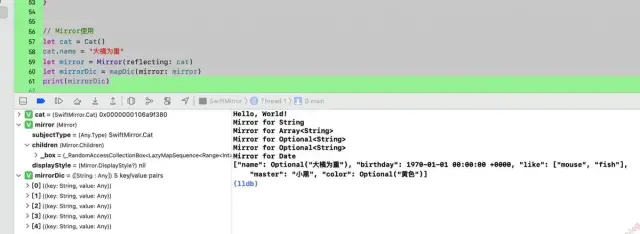
йҖҡиҝҮжү“еҚ°з»“жһңжҲ‘们еҸҜд»ҘзңӢеҲ°пјҢеҜ№дәҺдёҖдәӣеҹәжң¬зұ»еһӢпјҢе·Із»ҸеҸҜйҖүзұ»еһӢзҡ„ж•°жҚ®йғҪе·Із»ҸиҪ¬жҚўдёәеӯ—е…ёеҖјпјҢеҜ№дәҺз§ҒжңүеұһжҖ§д№ҹеҸҜд»Ҙе®ҢжҲҗиҪ¬жҚўгҖӮеҰӮжһңйҮҢйқўеҢ…еҗ«зұ»еҲҷиҝҳйңҖиҰҒиҝӣиЎҢйҖ’еҪ’еӨ„зҗҶгҖӮ
жіЁпјҡиҝҷйҮҢ并没жңүзңҹжӯЈзҡ„иҪ¬жҚўжҲҗjsonеӯ—з¬ҰдёІпјҢиҝҳжҳҜеҸӘиҪ¬жҚўжҲҗдәҶеӯ—е…ёпјҢйҮҚиҰҒеңЁжҖқжғіпјҢеҰӮжһңйңҖиҰҒиҪ¬жҚўжҲҗjsonиҝҳйңҖиҰҒеҫҲеӨҡдјҳеҢ–пјҢд»ҘеҸҠзү№ж®Ҡеӯ—з¬ҰдёІзҡ„иҖғйҮҸгҖӮ
е…¶е®һжҸҗеҲ°еҸҚе°„жҲ‘们жғіеҲ°жңҖеӨҡзҡ„еә”иҜҘе°ұжҳҜJSONдәҶпјҢиҝҷйҮҢжҲ‘们еҲ©з”ЁMirrorзҡ„зү№жҖ§пјҢе°ҶеҜ№иұЎиҪ¬жҚўжҲҗеӯ—е…ёпјҢеҜ№еҹәжң¬зұ»еһӢе’Ңзұ»еҒҡдәҶзӣёеә”зҡ„еӨ„зҗҶпјҢдҪ“дјҡдёҖдёӢиҪ¬jsonзҡ„жҖқи·ҜгҖӮ
йҰ–е…ҲжҲ‘们е®ҡд№үдёҖдёӘPersonеҜ№иұЎпјҢд»Јз ҒеҰӮдёӢпјҡ
struct Person { var name: String = "xiaohei" var age: Int = 18 var isMale: Bool = true var address: Address? = Address(street: "xizhimen North") var height = 1.85 var like: Array = ["eat", "sleep", "play"] var weight: Float = 75.0 var some: Int? } struct Address { var street: String } // еҲӣе»әдёҖдёӘPersonеҜ№иұЎ let p = Person()дёәдәҶйҖҡз”ЁжҖ§пјҢжҲ‘们еҸҜд»Ҙзј–еҶҷдёҖдёӘеҚҸи®®пјҢз”ЁжқҘдёәжүҖжңүзұ»еһӢжҸҗдҫӣиҪ¬жҚўзҡ„ж–№жі•пјҢеҸӘйңҖиҰҒйҒөе®ҲиҜҘеҚҸи®®е°ұеҸҜд»ҘдҪҝз”ЁеҚҸи®®дёӯзҡ„ж–№жі•гҖӮ
//еҸҜд»ҘиҪ¬жҚўдёә Json зҡ„еҚҸи®® protocol CustomJSONProtocol { func toJSON() throws -> Any? }еҚҸи®®зҡ„е®һзҺ°иҝҮзЁӢдёӯдјҡжңүдәӣй”ҷиҜҜпјҢжҲ‘们д№ҹз®ҖеҚ•зҡ„е®ҡд№үдёӘжһҡдёҫпјҢж–№дҫҝеӨ„зҗҶгҖӮдёәдәҶжӣҙеҠ иҜҰз»Ҷзҡ„жҸҸиҝ°й”ҷиҜҜдҝЎжҒҜпјҢжҲ‘们添еҠ дәҶй”ҷиҜҜжҸҸиҝ°е’Ңй”ҷиҜҜ codeгҖӮ
// иҪ¬ json ж—¶зҡ„й”ҷиҜҜзұ»еһӢ enum JSONMapError: Error{ case emptyKey case notConformProtocol } // й”ҷиҜҜжҸҸиҝ° extension JSONMapError: LocalizedError{ var errorDescription: String?{ switch self { case .emptyKey: return "key дёәз©ә" case .notConformProtocol: return "жІЎйҒөе®ҲеҚҸи®®" } } } // errorcode extension JSONMapError: CustomNSError{ var errorCode: Int{ switch self { case .emptyKey: return 100 case .notConformProtocol: return 101 } } }еҚҸи®®е®һзҺ°зҡ„д»Јз Ғпјҡ
extension CustomJSONProtocol { func toJSON() throws -> Any? { //еҲӣе»ә Mirror зұ»еһӢ let mirror = Mirror(reflecting: self) // еҰӮжһңжІЎжңүеұһжҖ§пјҢжҜ”еҰӮдёҖиҲ¬зұ»еһӢStringгҖҒIntзӯүпјҢзӣҙжҺҘиҝ”еӣһиҮӘе·ұ guard !mirror.children.isEmpty else { return self } var result: [String:Any] = [:] // йҒҚеҺҶ for children in mirror.children { if let value = children.value as? CustomJSONProtocol{ if let key = children.label { print(key) result[key] = try value.toJSON() } else { throw JSONMapError.emptyKey } } else { throw JSONMapError.notConformProtocol } } return result } }е°Ҷз”ЁеҲ°зҡ„зұ»еһӢйғҪйҒөе®ҲеҚҸи®®
//е°ҶдёҖиҲ¬зұ»еһӢйғҪйҒөд»Һ CustomJSONProtocol еҚҸи®® extension Person: CustomJSONProtocol {} extension String: CustomJSONProtocol {} extension Int: CustomJSONProtocol {} extension Bool: CustomJSONProtocol {} extension Double: CustomJSONProtocol {} extension Float: CustomJSONProtocol {} extension Address: CustomJSONProtocol {} // ж•°з»„йңҖиҰҒеҚ•зӢ¬еӨ„зҗҶпјҢиҰҒдёҚ然е°ұдјҡжҠҘй”ҷemptyKey extension Array: CustomJSONProtocol { func toJSON() throws -> Any? { return self } } //Optionai йңҖиҰҒзү№еҲ«еҜ№еҫ…пјҢеҺҹеӣ жҳҜеҰӮжһңзӣҙжҺҘиҝ”еӣһпјҢеҲҷдјҡжҳҜ .Some: [...] extension Optional: CustomJSONProtocol { func toJSON() throws -> Any? { if let x = self { if let value = x as? CustomJSONProtocol { return try value.toJSON() } throw JSONMapError.notConformProtocol } return nil } }жңҖеҗҺжҲ‘们жү“еҚ°дёҖдёӢпјҡ
do { print(try p.toJSON()!) } catch { print(error.localizedDescription) print((error as? JSONMapError)?.errorCode) }жү“еҚ°з»“жһңпјҡ

жҲ‘们зңӢеҲ°пјҢеҜ№дәҺsomeиҝҷз©әеҖјпјҢ并没жңүеӯҳеӮЁеҲ°еӯ—е…ёдёӯпјҢеӣ дёәswiftдёӯзҡ„еӯ—е…ёеҜ№дәҺз©әеҖјжҳҜеҲ йҷӨзҡ„ж„ҸжҖқгҖӮ
еҰӮжһңжғіе°Ҷе…¶иҪ¬жҚўжҲҗjsonиҝҳйңҖдҝ®ж”№"[]"дёә"{}"пјҢиҝҷдёӘеҜ№дәҺж•°з»„е’ҢеҜ№иұЎиҝҳдёҚеҘҪеҢәеҲҶпјҢеҸҰеӨ–еҜ№дәҺjsonеӯ—з¬ҰдёІеҶ…зҡ„дёҖдәӣvalueд№ҹжңүеҸҜиғҪжҳҜеә”дёҖдёІjsonиҝҳйңҖиҰҒж·»еҠ иҪ¬д№үеӯ—з¬ҰзӯүгҖӮ
жүҖд»ҘжҖ»зҡ„жқҘиҜҙпјҢжҖқи·ҜжҳҜиҝҷж ·зҡ„пјҢиҰҒжғізңҹжӯЈзҡ„еҒҡжҲҗйҖҡз”Ёзҡ„иҪ¬jsonзҡ„ж–№жЎҲиҝҳйңҖиҰҒеҫҲеӨҡзҡ„дјҳеҢ–пјҢжҜ”еҰӮиҜҙпјҢжҲ‘们дёҚеҸҜиғҪе°ҶжүҖжңүзҡ„еҹәжң¬зұ»еһӢйғҪеҺ»йҒөе®ҲдёҖдёӘеҚҸи®®пјҢиҝҷж—¶еҖҷжҲ‘们д№ҹеҸҜд»ҘиҖғиҷ‘дҪҝз”ЁжіӣеһӢеҺ»дҪңдёәж–№жі•зҡ„еҸӮж•°гҖӮ
еңЁжң¬з« иҠӮжҲ‘们е°ҶеҲҶжһҗMirrorзҡ„йғЁеҲҶжәҗз ҒпјҢжҹҘзңӢе…¶еә•еұӮе®һзҺ°пјҢжңҖеҗҺйҖҡиҝҮSwiftд»Јз ҒдҪҝз”ЁеҶ…еӯҳйҮҚз»‘е®ҡзҡ„еҪўејҸпјҢд»ҝеҶҷдёҖдёӢMirrorпјҢжқҘжӣҙеҘҪзҡ„жҺўзҙўMirrorзҡ„еҺҹзҗҶпјҢзҗҶи§ЈMirrorзҡ„жҖқжғігҖӮ
жҲ‘们зҹҘйҒ“SwiftжҳҜдёҖй—ЁйқҷжҖҒиҜӯиЁҖпјҢйӮЈд№ҲеңЁеә•еұӮжҳҜеҰӮдҪ•е®һзҺ°зҡ„иҺ·еҸ–еҜ№еә”зҡ„еұһжҖ§еҖјзҡ„е‘ў?еҸҲжҲ–иҖ…иҜҙSwiftзҡ„еҸҚе°„зү№жҖ§жҳҜеҰӮдҪ•е®һзҺ°зҡ„е‘ў?дёӢйқўжҲ‘们йҖҡиҝҮеҜ№Mirrorеә•еұӮжәҗз Ғзҡ„жҺўзҙўжқҘеҜ»жүҫзӯ”жЎҲгҖӮ
Mirrorзҡ„е®һзҺ°жҳҜз”ұдёҖйғЁеҲҶSwiftд»Јз ҒеҠ дёҠеҸҰдёҖйғЁеҲҶC++д»Јз ҒгҖӮSwiftд»Јз Ғе®һзҺ°еңЁReflectionMirror.swiftж–Ү件дёӯпјҢC++д»Јз Ғе®һзҺ°еңЁReflectionMirror.mmж–Ү件дёӯгҖӮSwiftжӣҙйҖӮеҗҲз”ЁеңЁе®һзҺ°жӣҙSwiftзҡ„жҺҘеҸЈпјҢдҪҶжҳҜеңЁSwiftдёӯдёҚиғҪзӣҙжҺҘи®ҝй—®C++зҡ„зұ»гҖӮиҝҷйҮҢдҪҝз”ЁдәҶ@_silgen_nameжқҘе®һзҺ°Swiftи°ғз”ЁC++дёӯзҡ„ж–№жі•гҖӮдёҫдёӘдҫӢеӯҗпјҡ
@_silgen_name("swift_reflectionMirror_count") internal func _getChildCount<T>(_: T, type: Any.Type) -> Int@_silgen_nameдҝ®йҘ°з¬ҰдјҡйҖҡзҹҘSwiftзј–иҜ‘еҷЁе°ҶиҝҷдёӘеҮҪж•°жҳ е°„жҲҗswift_reflectionMirror_countз¬ҰеҸ·пјҢиҖҢдёҚжҳҜSwiftйҖҡеёёеҜ№еә”еҲ°зҡ„_getChildCountж–№жі•еҗҚдҝ®йҘ°гҖӮйңҖиҰҒжіЁж„Ҹзҡ„жҳҜпјҢжңҖеүҚйқўзҡ„дёӢеҲ’зәҝиЎЁзӨәиҝҷдёӘдҝ®йҘ°жҳҜиў«дҝқз•ҷеңЁж ҮеҮҶеә“дёӯзҡ„гҖӮеңЁC++иҝҷиҫ№пјҢиҝҷдёӘеҮҪж•°жҳҜиҝҷж ·зҡ„гҖӮ
// func _getChildCount<T>(_: T, type: Any.Type) -> Int SWIFT_CC(swift) SWIFT_RUNTIME_STDLIB_API intptr_t swift_reflectionMirror_count(OpaqueValue *value, const Metadata *type, const Metadata *T) { return call(value, T, type, [](ReflectionMirrorImpl *impl) { return impl->count(); }); }SWIFT_CC(swift)дјҡе‘ҠиҜүзј–иҜ‘еҷЁиҝҷдёӘеҮҪж•°дҪҝз”Ёзҡ„жҳҜSwiftзҡ„и°ғз”ЁзәҰе®ҡпјҢиҖҢдёҚжҳҜC/C++зҡ„пјҢSWIFT_RUNTIME_STDLIB_APIж Үи®°иҝҷдёӘеҮҪж•°пјҢеңЁSwiftдҫ§зҡ„дёҖйғЁеҲҶжҺҘеҸЈдёӯпјҢиҖҢдё”е®ғиҝҳжңүж Үи®°дёәextern "C"зҡ„дҪңз”ЁпјҢд»ҺиҖҢйҒҝе…ҚC++зҡ„ж–№жі•еҗҚдҝ®йҘ°пјҢ并确дҝқе®ғеңЁSwiftдҫ§дјҡжңүйў„жңҹзҡ„з¬ҰеҸ·гҖӮеҗҢж—¶C++зҡ„еҸӮж•°дјҡеҺ»зү№ж„ҸеҢ№й…ҚеңЁSwiftдёӯеЈ°жҳҺзҡ„еҮҪж•°и°ғз”ЁгҖӮеҪ“Swiftи°ғз”Ё_getChildCountж—¶пјҢC++дјҡз”ЁеҢ…еҗ«SwiftеҖјжҢҮй’Ҳзҡ„valueпјҢеҢ…еҗ«зұ»еһӢеҸӮж•°typeпјҢеҢ…еҗ«зұ»еһӢе“Қеә”зҡ„жіӣеһӢ
з®ҖеҚ•зҡ„иҜҙе°ұжҳҜдҪҝз”Ё@_silgen_name("xxx")дҝ®йҘ°з¬Ұдҝ®йҘ°зҡ„Swiftж–№жі•дјҡи°ғз”ЁжӢ¬еҸ·дёӯзҡ„xxxзҡ„з¬ҰеҸ·пјҢдёҚз®ЎжҳҜC++зҡ„иҝҳжҳҜCзҡ„йғҪеҸҜд»ҘгҖӮ
Mirrorзҡ„еңЁSwiftе’ҢC++д№Ӣй—ҙзҡ„е…ЁйғЁжҺҘеҸЈз”ұд»ҘдёӢеҮҪж•°з»„жҲҗпјҡ
@_silgen_name("swift_isClassType") internal func _isClassType(_: Any.Type) -> Bool @_silgen_name("swift_getMetadataKind") internal func _metadataKind(_: Any.Type) -> UInt @_silgen_name("swift_reflectionMirror_normalizedType") internal func _getNormalizedType<T>(_: T, type: Any.Type) -> Any.Type @_silgen_name("swift_reflectionMirror_count") internal func _getChildCount<T>(_: T, type: Any.Type) -> Int @_silgen_name("swift_reflectionMirror_recursiveCount") internal func _getRecursiveChildCount(_: Any.Type) -> Int @_silgen_name("swift_reflectionMirror_recursiveChildMetadata") internal func _getChildMetadata( _: Any.Type, index: Int, outName: UnsafeMutablePointer<UnsafePointer<CChar>?>, outFreeFunc: UnsafeMutablePointer<NameFreeFunc?> ) -> Any.Type @_silgen_name("swift_reflectionMirror_recursiveChildOffset") internal func _getChildOffset( _: Any.Type, index: Int ) -> Int internal typealias NameFreeFunc = @convention(c) (UnsafePointer<CChar>?) -> Void @_silgen_name("swift_reflectionMirror_subscript") internal func _getChild<T>( of: T, type: Any.Type, index: Int, outName: UnsafeMutablePointer<UnsafePointer<CChar>?>, outFreeFunc: UnsafeMutablePointer<NameFreeFunc?> ) -> Any // Returns 'c' (class), 'e' (enum), 's' (struct), 't' (tuple), or '\0' (none) @_silgen_name("swift_reflectionMirror_displayStyle") internal func _getDisplayStyle<T>(_: T) -> CChar internal func getChild<T>(of value: T, type: Any.Type, index: Int) -> (label: String?, value: Any) { var nameC: UnsafePointer<CChar>? = nil var freeFunc: NameFreeFunc? = nil let value = _getChild(of: value, type: type, index: index, outName: &nameC, outFreeFunc: &freeFunc) let name = nameC.flatMap({ String(validatingUTF8: $0) }) freeFunc?(nameC) return (name, value) } #if _runtime(_ObjC) @_silgen_name("swift_reflectionMirror_quickLookObject") internal func _getQuickLookObject<T>(_: T) -> AnyObject? @_silgen_name("_swift_stdlib_NSObject_isKindOfClass") internal func _isImpl(_ object: AnyObject, kindOf: UnsafePointer<CChar>) -> BoolеңЁдёҖејҖе§ӢжҲ‘们з®ҖеҚ•зҡ„д»Ӣз»ҚдәҶMirrorзҡ„йғЁеҲҶжәҗз ҒпјҢд№ҹз”ұжӯӨзҹҘйҒ“Mirror(reflecting:)еҲқе§ӢеҢ–ж–№жі•еҸҜд»ҘжҺҘеҸ—д»»ж„ҸеҖјпјҢиҝ”еӣһдёҖдёӘжҸҗдҫӣиҜҘеҖјеӯҗе…ғзҙ йӣҶеҗҲChildrenзҡ„зӣёе…ідҝЎжҒҜзҡ„е®һдҫӢгҖӮ
йҖҡиҝҮMirror(reflecting:)жәҗз ҒжҲ‘们еҸҜд»ҘзҹҘйҒ“пјҢе…¶еә•еұӮи°ғз”Ёзҡ„жҳҜinternalReflectingж–№жі•гҖӮеңЁReflectionMirror.swiftж–Ү件зҡ„extension MirrorдёӯжҲ‘们еҸҜд»ҘжүҫеҲ°иҜҘж–№жі•гҖӮе…¶жәҗз ҒеҰӮдёӢпјҡ
internal init(internalReflecting subject: Any, subjectType: Any.Type? = nil, customAncestor: Mirror? = nil) { let subjectType = subjectType ?? _getNormalizedType(subject, type: type(of: subject)) let childCount = _getChildCount(subject, type: subjectType) let children = (0 ..< childCount).lazy.map({ getChild(of: subject, type: subjectType, index: $0) }) self.children = Children(children) self._makeSuperclassMirror = { guard let subjectClass = subjectType as? AnyClass, let superclass = _getSuperclass(subjectClass) else { return nil } // Handle custom ancestors. If we've hit the custom ancestor's subject type, // or descendants are suppressed, return it. Otherwise continue reflecting. if let customAncestor = customAncestor { if superclass == customAncestor.subjectType { return customAncestor } if customAncestor._defaultDescendantRepresentation == .suppressed { return customAncestor } } return Mirror(internalReflecting: subject, subjectType: superclass, customAncestor: customAncestor) } let rawDisplayStyle = _getDisplayStyle(subject) switch UnicodeScalar(Int(rawDisplayStyle)) { case "c": self.displayStyle = .class case "e": self.displayStyle = .enum case "s": self.displayStyle = .struct case "t": self.displayStyle = .tuple case "\0": self.displayStyle = nil default: preconditionFailure("Unknown raw display style '\(rawDisplayStyle)'") } self.subjectType = subjectType self._defaultDescendantRepresentation = .generated }жәҗз ҒеҲҶжһҗпјҡ
йҰ–е…ҲжҳҜиҺ·еҸ–subjectTypeпјҢеҰӮжһңдј е…Ҙзҡ„жңүеҖје°ұдҪҝз”Ёдј е…Ҙзҡ„еҖјпјҢеҗҰеҲҷе°ұйҖҡиҝҮ_getNormalizedTypeеҮҪж•°еҺ»иҺ·еҸ–
жҺҘдёӢжқҘе°ұжҳҜйҖҡиҝҮ_getChildCountиҺ·еҸ–childCount
жҺҘдёӢжқҘжҳҜchildrenпјҢжіЁж„ҸиҝҷйҮҢжҳҜжҮ’еҠ иҪҪзҡ„
зҙ§жҺҘзқҖжҳҜSuperclassMirrorпјҢиҝҷйҮҢдҪҝз”Ёзҡ„жҳҜдёҖдёӘй—ӯеҢ…зҡ„еҪўејҸ
жңҖеҗҺдјҡиҺ·еҸ–并解жһҗжҳҫзӨәзҡ„ж ·ејҸпјҢ并и®ҫзҪ®Mirrorеү©дёӢзҡ„еұһжҖ§гҖӮ
дёӢйқўжҲ‘们е°ұжқҘзңӢзңӢ_getNormalizedTypeеҮҪж•°еҶ…йғЁзҡ„е®һзҺ°гҖӮж №жҚ®дёҠйқўзҡ„еҲҶжһҗжҲ‘们зҹҘйҒ“е®һйҷ…и°ғз”ЁжҳҜswift_reflectionMirror_normalizedTypeгҖӮеңЁReflectionMirror.mmж–Ү件дёӯжҲ‘们еҸҜд»ҘзңӢеҲ°е…¶жәҗз Ғпјҡ
// func _getNormalizedType<T>(_: T, type: Any.Type) -> Any.Type SWIFT_CC(swift) SWIFT_RUNTIME_STDLIB_API const Metadata *swift_reflectionMirror_normalizedType(OpaqueValue *value, const Metadata *type, const Metadata *T) { return call(value, T, type, [](ReflectionMirrorImpl *impl) { return impl->type; }); }жҲ‘们еҸҜд»ҘзңӢеҲ°иҝҷйҮҢи°ғз”ЁдәҶдёҖдёӘcallеҮҪж•°пјҢжңҖеҗҺиҝ”еӣһзҡ„жҳҜimplзҡ„typeгҖӮйҰ–е…ҲжҲ‘们зңӢзңӢиҝҷcallеҮҪж•°пјҡ
template<typename F> auto call(OpaqueValue *passedValue, const Metadata *T, const Metadata *passedType, const F &f) -> decltype(f(nullptr)) { const Metadata *type; OpaqueValue *value; std::tie(type, value) = unwrapExistential(T, passedValue); if (passedType != nullptr) { type = passedType; } auto call = [&](ReflectionMirrorImpl *impl) { impl->type = type; impl->value = value; auto result = f(impl); return result; }; auto callClass = [&] { if (passedType == nullptr) { // Get the runtime type of the object. const void *obj = *reinterpret_cast<const void * const *>(value); auto isa = _swift_getClass(obj); // Look through artificial subclasses. while (isa->isTypeMetadata() && isa->isArtificialSubclass()) { isa = isa->Superclass; } passedType = isa; } #if SWIFT_OBJC_INTEROP // If this is a pure ObjC class, reflect it using ObjC's runtime facilities. // ForeignClass (e.g. CF classes) manifests as a NULL class object. auto *classObject = passedType->getClassObject(); if (classObject == nullptr || !classObject->isTypeMetadata()) { ObjCClassImpl impl; return call(&impl); } #endif // Otherwise, use the native Swift facilities. ClassImpl impl; return call(&impl); }; switch (type->getKind()) { case MetadataKind::Tuple: { TupleImpl impl; return call(&impl); } case MetadataKind::Struct: { StructImpl impl; return call(&impl); } case MetadataKind::Enum: case MetadataKind::Optional: { EnumImpl impl; return call(&impl); } case MetadataKind::ObjCClassWrapper: case MetadataKind::ForeignClass: case MetadataKind::Class: { return callClass(); } case MetadataKind::Metatype: case MetadataKind::ExistentialMetatype: { MetatypeImpl impl; return call(&impl); } case MetadataKind::Opaque: { #if SWIFT_OBJC_INTEROP // If this is the AnyObject type, use the dynamic type of the // object reference. if (type == &METADATA_SYM(BO).base) { return callClass(); } #endif // If this is the Builtin.NativeObject type, and the heap object is a // class instance, use the dynamic type of the object reference. if (type == &METADATA_SYM(Bo).base) { const HeapObject *obj = *reinterpret_cast<const HeapObject * const*>(value); if (obj->metadata->getKind() == MetadataKind::Class) { return callClass(); } } LLVM_FALLTHROUGH; } /// TODO: Implement specialized mirror witnesses for all kinds. default: break; // Types can't have these kinds. case MetadataKind::HeapLocalVariable: case MetadataKind::HeapGenericLocalVariable: case MetadataKind::ErrorObject: swift::crash("Swift mirror lookup failure"); } // If we have an unknown kind of type, or a type without special handling, // treat it as opaque. OpaqueImpl impl; return call(&impl); }д№ҚдёҖзңӢиҝҷдёӘcallеҮҪж•°д»Јз ҒзӣёеҜ№жңүзӮ№еӨҡпјҢе…¶е®һдё»иҰҒе°ұжҳҜдёҖдёӘеӨ§еһӢзҡ„switchеЈ°жҳҺпјҢе’ҢдёҖдәӣеҜ№зү№ж®Ҡжғ…еҶөзҡ„еӨ„зҗҶпјҢиҝҷйҮҢйҮҚиҰҒзҡ„е°ұжҳҜпјҢе®ғдјҡз”ЁдёҖдёӘReflectionMirrorImplзҡ„еӯҗзұ»е®һдҫӢеҺ»з»“жқҹи°ғз”ЁfпјҢ然еҗҺдјҡи°ғз”ЁиҝҷдёӘе®һдҫӢдёҠзҡ„ж–№жі•еҺ»и®©зңҹжӯЈзҡ„е·ҘдҪңе®ҢжҲҗпјҢиҝҷд№ҹе°ұжҳҜдёәд»Җд№ҲеңЁswift_reflectionMirror_normalizedTypeеҮҪж•°дёӯжңҖеҗҺдјҡreturn impl->type;ж„ҹе…ҙи¶Јзҡ„еҸҜд»ҘйҖҡиҝҮжәҗз ҒеҺ»и°ғиҜ•дёҖдёӢпјҢиҝҷйҮҢжҲ‘д№ҹи°ғиҜ•дәҶпјҢжІЎд»Җд№ҲжҢҮзҡ„иҜҙзҡ„пјҢиҝҷе°ұе°ұдёҚеҶҷи°ғиҜ•иҝҮзЁӢдәҶпјҢдёӢйқўжҲ‘们е°ұжқҘзңӢзңӢReflectionMirrorImplгҖӮ
ReflectionMirrorImplжңүд»ҘдёӢ6дёӘеӯҗзұ»пјҡ
TupleImpl е…ғз»„зҡ„еҸҚе°„
StructImpl з»“жһ„дҪ“зҡ„еҸҚе°„
EnumImpl жһҡдёҫзҡ„еҸҚе°„
ClassImpl зұ»зҡ„еҸҚе°„
MetatypeImpl е…ғж•°жҚ®зҡ„еҸҚе°„
OpaqueImpl дёҚйҖҸжҳҺзұ»еһӢзҡ„еҸҚе°„
// Abstract base class for reflection implementations. struct ReflectionMirrorImpl { const Metadata *type; OpaqueValue *value; virtual char displayStyle() = 0; virtual intptr_t count() = 0; virtual intptr_t childOffset(intptr_t index) = 0; virtual const FieldType childMetadata(intptr_t index, const char **outName, void (**outFreeFunc)(const char *)) = 0; virtual AnyReturn subscript(intptr_t index, const char **outName, void (**outFreeFunc)(const char *)) = 0; virtual const char *enumCaseName() { return nullptr; } #if SWIFT_OBJC_INTEROP virtual id quickLookObject() { return nil; } #endif // For class types, traverse through superclasses when providing field // information. The base implementations call through to their local-only // counterparts. virtual intptr_t recursiveCount() { return count(); } virtual intptr_t recursiveChildOffset(intptr_t index) { return childOffset(index); } virtual const FieldType recursiveChildMetadata(intptr_t index, const char **outName, void (**outFreeFunc)(const char *)) { return childMetadata(index, outName, outFreeFunc); } virtual ~ReflectionMirrorImpl() {} };ReflectionMirrorImplжәҗз ҒдёҚеӨҡпјҢдҪҶжҳҜжҲ‘们еҸҜд»ҘзңӢеҲ°typeд»ҘеҸҠcountзӯүйғҪеңЁе…¶дёӯгҖӮдёӢйқўжҲ‘们д»Ҙз»“жһ„дҪ“дёәдҫӢпјҢзңӢзңӢе…¶еӯҗзұ»зҡ„жәҗз ҒгҖӮ
// Implementation for structs. struct StructImpl : ReflectionMirrorImpl { bool isReflectable() { const auto *Struct = static_cast<const StructMetadata *>(type); const auto &Description = Struct->getDescription(); return Description->isReflectable(); } char displayStyle() { return 's'; } intptr_t count() { if (!isReflectable()) { return 0; } auto *Struct = static_cast<const StructMetadata *>(type); return Struct->getDescription()->NumFields; } intptr_t childOffset(intptr_t i) { auto *Struct = static_cast<const StructMetadata *>(type); if (i < 0 || (size_t)i > Struct->getDescription()->NumFields) swift::crash("Swift mirror subscript bounds check failure"); // Load the offset from its respective vector. return Struct->getFieldOffsets()[i]; } const FieldType childMetadata(intptr_t i, const char **outName, void (**outFreeFunc)(const char *)) { StringRef name; FieldType fieldInfo; std::tie(name, fieldInfo) = getFieldAt(type, i); assert(!fieldInfo.isIndirect() && "indirect struct fields not implemented"); *outName = name.data(); *outFreeFunc = nullptr; return fieldInfo; } AnyReturn subscript(intptr_t i, const char **outName, void (**outFreeFunc)(const char *)) { auto fieldInfo = childMetadata(i, outName, outFreeFunc); auto *bytes = reinterpret_cast<char*>(value); auto fieldOffset = childOffset(i); auto *fieldData = reinterpret_cast<OpaqueValue *>(bytes + fieldOffset); return copyFieldContents(fieldData, fieldInfo); } };йҰ–е…ҲдёҖдёӘеҲӨж–ӯжҳҜеҗҰж”ҜжҢҒеҸҚе°„зҡ„ж–№жі•пјҢжңҖдёӯжҳҜи®ҝй—®зҡ„Description->isReflectable()
иҝҷйҮҢдҪҝз”Ё‘s’жқҘжҳҫејҸзҡ„иЎЁжҳҺиҝҷжҳҜдёҖдёӘз»“жһ„дҪ“
然еҗҺжҳҜиҺ·еҸ–еұһжҖ§дёӘж•°
зҙ§жҺҘзқҖжҳҜиҺ·еҸ–жҜҸдёӘеұһжҖ§зҡ„еҒҸ移еҖј
然еҗҺиҺ·еҸ–дәҶFieldTypeеҶ…йғЁиҝҳеҸҜд»ҘиҺ·еҸ–еҲ°еұһжҖ§зҡ„еҗҚз§°гҖӮ
жңҖеҗҺsubscriptж–№жі•еҸҜд»ҘиҺ·еҸ–еҲ°еұһжҖ§еҗҚз§°е’ҢеұһжҖ§еҒҸ移зҡ„жҢҮй’ҲпјҢд№ҹе°ұжҳҜеұһжҖ§еҖјгҖӮ
еңЁжӯӨеӨ„жҲ‘们зңӢеҲ°еҫҲеӨҡе…ідәҺDescriptionзҡ„д»Јз ҒпјҢзңӢжқҘиҝҷдёӘDescriptionеӯҳеӮЁзқҖеҫҲеӨҡдҝЎжҒҜпјҢеңЁиҺ·еҸ–Descriptionзҡ„ж—¶еҖҷжҳҜд»ҺStructMetadataйҖҡиҝҮgetDescription()ж–№жі•иҺ·еҸ–еҲ°гҖӮжүҖд»ҘиҝҷдәӣдҝЎжҒҜеҹәжң¬зЎ®е®ҡжҳҜд»ҺMetaDataдёӯиҺ·еҸ–еҲ°зҡ„гҖӮStructMetadataжҳҜTargetStructMetadataзҡ„еҲ«еҗҚпјҢжҲ‘们д»ҘжӯӨдёәдҫӢгҖӮ
еңЁTargetStructMetadataжҲ‘们еҸҜд»ҘзңӢеҲ°еҰӮдёӢд»Јз Ғпјҡ
const TargetStructDescriptor<Runtime> *getDescription() const { return llvm::cast<TargetStructDescriptor<Runtime>>(this->Description); }иҜҙжҳҺжӯӨеӨ„дјҡиҝ”еӣһдёҖдёӘTargetStructDescriptorзұ»еһӢзҡ„DescriptionпјҢдҪҶжҳҜеңЁиҝҷйҮҢ并没жңүжүҫеҲ°иҝҷдёӘеұһжҖ§пјҢеҸҜиғҪеңЁзҲ¶зұ»дёӯпјҢжҲ‘们еҸҜд»ҘзңӢеҲ°TargetStructMetadata继жүҝиҮӘTargetValueMetadataгҖӮ
еңЁиҝҷйҮҢжҲ‘们еҸҜд»ҘзңӢеҲ°еҰӮдёӢд»Јз Ғпјҡ
/// An out-of-line description of the type. TargetSignedPointer<Runtime, const TargetValueTypeDescriptor<Runtime> * __ptrauth_swift_type_descriptor> Description; getDescription() const { return Description; }иҝҷйҮҢжҲ‘们дҫҝжүҫеҲ°дәҶпјҡ
DescriptionеұһжҖ§пјҢе®ғзҡ„зұ»еһӢжҳҜTargetValueTypeDescriptorпјҢеә”иҜҘжҳҜTargetStructDescriptorзҡ„зҲ¶зұ»гҖӮ
getDescription()ж–№жі•пјҢеңЁTargetStructMetadataжҳҜйҮҚеҶҷзҡ„иҝҷдёӘж–№жі•
и·іиҪ¬еҲ°TargetStructDescriptorдёӯеҗҺпјҢжҲ‘们еҸҜд»ҘзңӢеҲ°пјҡ
TargetValueTypeDescriptorжһң然жҳҜе®ғзҡ„зҲ¶зұ»
еңЁе…¶жәҗз ҒдёӯжҲ‘们иҝҳеҸҜд»ҘеҸ‘зҺ°дёӨдёӘеұһжҖ§пјҢеҲҶеҲ«жҳҜNumFieldsе’ҢFieldOffsetVectorOffsetжәҗз ҒеҰӮдёӢпјҡ
/// The number of stored properties in the struct. /// If there is a field offset vector, this is its length. uint32_t NumFields; /// The offset of the field offset vector for this struct's stored /// properties in its metadata, if any. 0 means there is no field offset /// vector. uint32_t FieldOffsetVectorOffset;
е…¶дёӯNumFieldsдё»иҰҒиЎЁзӨәз»“жһ„дҪ“дёӯеұһжҖ§зҡ„дёӘж•°пјҢеҰӮжһңеҸӘжңүдёҖдёӘеӯ—ж®өеҒҸ移йҮҸеҲҷиЎЁзӨәеҒҸ移йҮҸзҡ„й•ҝеәҰ
FieldOffsetVectorOffsetиЎЁзӨәиҝҷдёӘз»“жһ„дҪ“е…ғж•°жҚ®дёӯеӯҳеӮЁзҡ„еұһжҖ§зҡ„еӯ—ж®өеҒҸ移еҗ‘йҮҸзҡ„еҒҸ移йҮҸпјҢеҰӮжһңжҳҜ0еҲҷиЎЁзӨәжІЎжңү
жәҗз ҒеҰӮдёӢпјҢеҫҲе°‘пјҡ
template <typename Runtime> class TargetValueTypeDescriptor : public TargetTypeContextDescriptor<Runtime> { public: static bool classof(const TargetContextDescriptor<Runtime> *cd) { return cd->getKind() == ContextDescriptorKind::Struct || cd->getKind() == ContextDescriptorKind::Enum; } };еңЁиҝҷйҮҢжҲ‘们并没жңүжүҫеҲ°еӨӘеӨҡжңүз”Ёзҡ„дҝЎжҒҜпјҢжҲ‘们继з»ӯеҗ‘зҲ¶зұ»еҜ»жүҫпјҢ其继жүҝиҮӘTargetTypeContextDescriptor
йғЁеҲҶжәҗз Ғпјҡ
template <typename Runtime> class TargetTypeContextDescriptor : public TargetContextDescriptor<Runtime> { public: /// The name of the type. TargetRelativeDirectPointer<Runtime, const char, /*nullable*/ false> Name; /// A pointer to the metadata access function for this type. /// /// The function type here is a stand-in. You should use getAccessFunction() /// to wrap the function pointer in an accessor that uses the proper calling /// convention for a given number of arguments. TargetRelativeDirectPointer<Runtime, MetadataResponse(...), /*Nullable*/ true> AccessFunctionPtr; /// A pointer to the field descriptor for the type, if any. TargetRelativeDirectPointer<Runtime, const reflection::FieldDescriptor, /*nullable*/ true> Fields; }жҲ‘们еҸҜд»ҘзңӢеҲ°пјҡ
иҜҘзұ»з»§жүҝиҮӘTargetContextDescriptor
жңүNameгҖҒAccessFunctionPtrгҖҒFieldsдёүдёӘеұһжҖ§
е…¶дёӯnameе°ұжҳҜзұ»еһӢзҡ„еҗҚз§°
AccessFunctionPtrжҳҜиҜҘзұ»еһӢе…ғж•°жҚ®и®ҝй—®еҮҪж•°зҡ„жҢҮй’Ҳ
FieldsжҳҜдёҖдёӘжҢҮеҗ‘иҜҘзұ»еһӢзҡ„еӯ—ж®өжҸҸиҝ°з¬Ұзҡ„жҢҮй’Ҳ
жҺҘдёӢжқҘжҲ‘们еҶҚзңӢзңӢTargetTypeContextDescriptorзҡ„зҲ¶зұ»дёӯиҝҳжңүд»Җд№Ҳжңүз”Ёзҡ„дҝЎжҒҜгҖӮйғЁеҲҶжәҗз ҒеҰӮдёӢпјҡ
/// Base class for all context descriptors. template<typename Runtime> struct TargetContextDescriptor { /// Flags describing the context, including its kind and format version. ContextDescriptorFlags Flags; /// The parent context, or null if this is a top-level context. TargetRelativeContextPointer<Runtime> Parent; }иҝҷйҮҢжҲ‘们еҸҜд»ҘзңӢеҲ°пјҡ
иҝҷе°ұжҳҜdescriptorsзҡ„еҹәзұ»
жңүдёӨдёӘеұһжҖ§пјҢеҲҶеҲ«жҳҜFlagsе’ҢParent
е…¶дёӯFlagsжҳҜжҸҸиҝ°дёҠдёӢж–Үзҡ„ж Үеҝ—пјҢеҢ…жӢ¬е®ғзҡ„з§Қзұ»е’Ңж јејҸзүҲжң¬гҖӮ
ParentжҳҜи®°еҪ•зҲ¶зұ»дёҠдёӢж–Үзҡ„пјҢеҰӮжһңжҳҜйЎ¶зә§еҲҷдёәnull
иҮіжӯӨжҲ‘们еҜ№з»“жһ„дҪ“Descriptionзҡ„еұӮзә§з»“жһ„еҹәжң¬е°ұзҗҶжё…жҘҡдәҶпјҢзҺ°жҖ»з»“еҰӮдёӢпјҡ
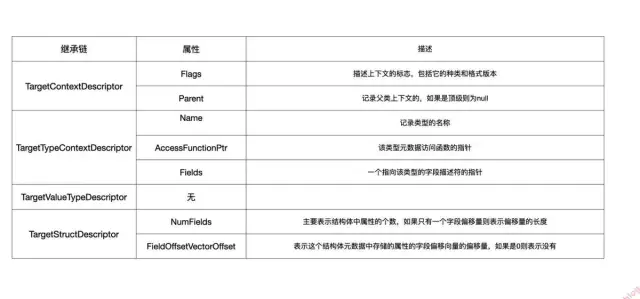
д»ҺдёҠеӣҫжҲ‘们еҸҜд»ҘзңӢеҲ°пјҢеҜ№дәҺдёҖдёӘз»“жһ„дҪ“зҡ„DescriptionжқҘиҜҙпјҢ继жүҝй“ҫдёҠдёҖе…ұеӣӣдёӘзұ»пјҢ7дёӘеұһжҖ§гҖӮдёӢйқўжҲ‘们е°ұеҜ№иҝҷдәӣеұһжҖ§дҪңиҝӣдёҖжӯҘзҡ„еҲҶжһҗ
Flagsзҡ„зұ»еһӢжҳҜContextDescriptorFlagsпјҢжҲ‘们зӮ№еҮ»и·іиҪ¬иҝӣеҺ»пјҢжҲ‘们еҸҜд»ҘзңӢеҲ°пјҡ
/// Common flags stored in the first 32-bit word of any context descriptor. struct ContextDescriptorFlags { private: uint32_t Value; explicit constexpr ContextDescriptorFlags(uint32_t Value) : Value(Value) {} public: constexpr ContextDescriptorFlags() : Value(0) {} constexpr ContextDescriptorFlags(ContextDescriptorKind kind, bool isGeneric, bool isUnique, uint8_t version, uint16_t kindSpecificFlags) : ContextDescriptorFlags(ContextDescriptorFlags() .withKind(kind) .withGeneric(isGeneric) .withUnique(isUnique) .withVersion(version) .withKindSpecificFlags(kindSpecificFlags)) {} ...... }д»Һд»ҘдёҠзҡ„д»Јз ҒдёӯжҲ‘们еҸҜд»ҘзңӢеҲ°иҝҷдёӘFLagsе®һйҷ…жҳҜдёӘuint32_tзҡ„еҖјпјҢжҢүдҪҚеӯҳеӮЁзқҖkindгҖҒisGenericгҖҒisUniqueгҖҒversionзӯүдҝЎжҒҜгҖӮ
Parentзҡ„зұ»еһӢжҳҜTargetRelativeContextPointer
using TargetRelativeContextPointer = RelativeIndirectablePointer<const Context<Runtime>, /*nullable*/ true, int32_t, TargetSignedContextPointer<Runtime, Context>>;
жҲ‘们еҸҜд»ҘзңӢеҲ°TargetRelativeContextPointerжҳҜеҸ–иҮӘRelativeIndirectablePointerзҡ„еҲ«еҗҚпјҢ继з»ӯзӮ№еҮ»иҝӣиЎҢжҹҘзңӢпјҡ
/// A relative reference to an object stored in memory. The reference may be /// direct or indirect, and uses the low bit of the (assumed at least /// 2-byte-aligned) pointer to differentiate. template<typename ValueTy, bool Nullable = false, typename Offset = int32_t, typename IndirectType = const ValueTy *> class RelativeIndirectablePointer { /// The relative offset of the pointer's memory from the `this` pointer. /// If the low bit is clear, this is a direct reference; otherwise, it is /// an indirect reference. Offset RelativeOffsetPlusIndirect; const ValueTy *get() const & { static_assert(alignof(ValueTy) >= 2 && alignof(Offset) >= 2, "alignment of value and offset must be at least 2 to " "make room for indirectable flag"); // Check for null. if (Nullable && RelativeOffsetPlusIndirect == 0) return nullptr; Offset offsetPlusIndirect = RelativeOffsetPlusIndirect; uintptr_t address = detail::applyRelativeOffset(this, offsetPlusIndirect & ~1); // If the low bit is set, then this is an indirect address. Otherwise, // it's direct. if (offsetPlusIndirect & 1) { return *reinterpret_cast<IndirectType const *>(address); } else { return reinterpret_cast<const ValueTy *>(address); } } }ж №жҚ®жіЁйҮҠжҲ‘们е°ұеҸҜд»ҘиҪ»жқҫзҡ„зҹҘйҒ“иҝҷдёӘзұ»зҡ„дё»иҰҒдҪңз”ЁжҳҜеӯҳеӮЁеңЁеҶ…еӯҳдёӯзҡ„еҜ№иұЎзҡ„зӣёеҜ№еј•з”ЁгҖӮиҝҷдёӘж„ҸжҖқеңЁеҗҺйқўд№ҹжңүзӣёе…ізҡ„и§ЈйҮҠе°ұжҳҜеңЁеҶ…еӯҳдёӯеј•з”ЁеҸҜд»ҘжҳҜзӣҙжҺҘзҡ„д№ҹеҸҜд»ҘжҳҜй—ҙжҺҘзҡ„пјҢзӣҙжҺҘзҡ„е°ұжҳҜеӯҳеӮЁзҡ„з»қеҜ№ең°еқҖ(д№ҹдёҚдёҖе®ҡпјҢиҝҳжңүASLRзӯү)пјҢзӣҙжҺҘи®ҝй—®иҝҷдёӘең°еқҖе°ұеҸҜд»ҘжӢҝеҲ°еҜ№еә”зҡ„ж•°жҚ®пјҢиҖҢиҝҷйҮҢзҡ„зӣёеҜ№еј•з”Ёе°ұжҳҜй—ҙжҺҘзҡ„пјҢиҝҷйҮҢйқўйҖҡиҝҮRelativeOffsetPlusIndirectеұһжҖ§еӯҳеӮЁзӣёеҜ№зҡ„ең°еқҖеҒҸ移йҮҸпјҢеңЁйҖҡиҝҮget()еҮҪж•°иҺ·еҸ–пјҢеңЁget()еҮҪж•°дёӯпјҢдјҡи°ғз”ЁapplyRelativeOffsetеҮҪж•°пјҢиҝӣиЎҢең°еқҖзҡ„еҒҸ移пјҢapplyRelativeOffsetжәҗз Ғпјҡ
/// Apply a relative offset to a base pointer. The offset is applied to the base /// pointer using sign-extended, wrapping arithmetic. template<typename BasePtrTy, typename Offset> static inline uintptr_t applyRelativeOffset(BasePtrTy *basePtr, Offset offset) { static_assert(std::is_integral<Offset>::value && std::is_signed<Offset>::value, "offset type should be signed integer"); auto base = reinterpret_cast<uintptr_t>(basePtr); // We want to do wrapping arithmetic, but with a sign-extended // offset. To do this in C, we need to do signed promotion to get // the sign extension, but we need to perform arithmetic on unsigned values, // since signed overflow is undefined behavior. auto extendOffset = (uintptr_t)(intptr_t)offset; return base + extendOffset; }жңҖеҗҺиҝ”еӣһзҡ„ж—¶еҖҷжҲ‘们еҸҜд»ҘзңӢеҲ°base + extendOffset;еҹәең°еқҖеҠ дёҠеҒҸ移зҡ„еҖјпјҢжңҖеҗҺеҫ—еҲ°зңҹе®һзҡ„ең°еқҖгҖӮ
nameзҡ„зұ»еһӢжҳҜTargetRelativeDirectPointer
template <typename Runtime, typename Pointee, bool Nullable = true> using TargetRelativeDirectPointer = typename Runtime::template RelativeDirectPointer<Pointee, Nullable>;
иҝҷйҮҢдҫқж—§жҳҜеҸ–еҲ«еҗҚпјҢ继з»ӯи·іиҪ¬еҲ°RelativeDirectPointerпјҢиҝҷйҮҢжңүдёӨдёӘйҖүжӢ©пјҢжҲ‘们йҖүжӢ©зӣёеҜ№еј•з”ЁйӮЈдёӘпјҲйҖҡиҝҮжіЁйҮҠеҢәеҲ«пјүгҖӮжәҗз ҒеҰӮдёӢпјҡ
/// A direct relative reference to an object that is not a function pointer. template <typename T, bool Nullable, typename Offset> class RelativeDirectPointer<T, Nullable, Offset, typename std::enable_if<!std::is_function<T>::value>::type> : private RelativeDirectPointerImpl<T, Nullable, Offset> { using super = RelativeDirectPointerImpl<T, Nullable, Offset>; public: using super::get; using super::super; RelativeDirectPointer &operator=(T *absolute) & { super::operator=(absolute); return *this; } operator typename super::PointerTy() const & { return this->get(); } const typename super::ValueTy *operator->() const & { return this->get(); } using super::isNull; };еңЁжәҗз ҒдёӯжҲ‘们еҸҜд»ҘзңӢеҲ°еҫҲеӨҡе…ідәҺsupperзҡ„дёңиҘҝпјҢжңүдёӨеӨ„йғҪжҳҜйҖҡиҝҮget()ж–№жі•иҝ”еӣһзҡ„пјҢеҲҶеҲ«жҳҜPointerTyе’ҢValueTyпјҢдёӢйқўжҲ‘们е°ұжқҘеҲ°зҲ¶зұ»ж–№жі•дёӯзңӢзңӢгҖӮзҲ¶зұ»жҳҜRelativeDirectPointerImplпјҢе…¶йғЁеҲҶжәҗз ҒеҰӮдёӢпјҡ
/// A relative reference to a function, intended to reference private metadata /// functions for the current executable or dynamic library image from /// position-independent constant data. template<typename T, bool Nullable, typename Offset> class RelativeDirectPointerImpl { private: /// The relative offset of the function's entry point from *this. Offset RelativeOffset; public: using ValueTy = T; using PointerTy = T*; PointerTy get() const & { // Check for null. if (Nullable && RelativeOffset == 0) return nullptr; // The value is addressed relative to `this`. uintptr_t absolute = detail::applyRelativeOffset(this, RelativeOffset); return reinterpret_cast<PointerTy>(absolute); } }иҝҷйҮҢеҗҢж ·жңүдёҖдёӘOffsetзұ»еһӢRelativeOffsetпјҢд»ҘеҸҠget()ж–№жі•пјҢеҗҢж ·get()ж–№жі•д№ҹдјҡи°ғз”ЁapplyRelativeOffsetеҮҪж•°иҝӣиЎҢең°еқҖзҡ„зӣёеҠ пјҢе…ідәҺapplyRelativeOffsetж–№жі•еңЁд»Ӣз»ҚParentзҡ„ж—¶еҖҷжҸҗеҲ°иҝҮгҖӮ
иҝҷйҮҢйқўеӨҡдәҶValueTyе’ҢPointerTyпјҢValueTyжҳҜдј е…ҘжіӣеһӢзҡ„еҖјпјҢPointerTyжҳҜе…¶жҢҮй’ҲгҖӮ
nameдёӯиҝҳжңүдёӘconst charпјҢиҝҷйҮҢжҳҜзӣҙжҺҘз”Ёconst charзұ»еһӢеӯҳеӮЁзҡ„зұ»еһӢзҡ„еҗҚз§°гҖӮ
AccessFunctionPtrзҡ„зұ»еһӢжҳҜTargetRelativeDirectPointer
и·ҹnameдёҖж ·зҡ„дҪҝз”ЁеҒҸ移жҢҮй’ҲTargetRelativeDirectPointerпјҢеҸӘдёҚиҝҮжҳҜconst charжӣҝжҚўжҲҗдәҶMetadataResponse(...)пјҢзӮ№еҮ»MetadataResponseи·іиҪ¬еҗҺжҲ‘们еҸҜд»ҘзңӢеҲ°еҰӮдёӢд»Јз Ғпјҡ
MetadataResponse() : Metadata(nullptr) {} /// A metadata response that might not be dynamically complete. explicit MetadataResponse(llvm::Value *metadata, llvm::Value *state, MetadataState staticLowerBoundState) : Metadata(metadata), DynamicState(state), StaticState(staticLowerBoundState) { assert(metadata && "must be valid"); }жүҖд»ҘиҝҷйҮҢеҸӘжҳҜдёҖдёӘMetadataзҡ„жҢҮй’ҲгҖӮ
Fieldsзҡ„зұ»еһӢжҳҜTargetRelativeDirectPointer
TargetRelativeDirectPointerе°ұдёҚеӨҡиҜҙдәҶпјҢиҝҷйҮҢзңӢзңӢFieldDescriptorзӮ№еҮ»и·іиҪ¬еҲ°е…¶жәҗз ҒеӨ„пјҢйғЁеҲҶжәҗз ҒеҰӮдёӢпјҡ
// Field descriptors contain a collection of field records for a single // class, struct or enum declaration. class FieldDescriptor { const FieldRecord *getFieldRecordBuffer() const { return reinterpret_cast<const FieldRecord *>(this + 1); } public: const RelativeDirectPointer<const char> MangledTypeName; const RelativeDirectPointer<const char> Superclass; FieldDescriptor() = delete; const FieldDescriptorKind Kind; const uint16_t FieldRecordSize; const uint32_t NumFields; }иҝҷйҮҢжңү5дёӘеұһжҖ§пјҡ
1. MangledTypeName
2. Superclass
3. kind
4. FieldRecordSize
5. NumFields
е…ідәҺgetFieldRecordBufferеҮҪж•°зҡ„иҝ”еӣһеҖјFieldRecordжәҗз ҒеҰӮдёӢпјҡ
class FieldRecord { const FieldRecordFlags Flags; public: const RelativeDirectPointer<const char> MangledTypeName; const RelativeDirectPointer<const char> FieldName; ..... }FieldRecordдё»иҰҒжҳҜе°ҒиЈ…дәҶдёҖдәӣеұһжҖ§пјҢз”ЁдәҺеӯҳеӮЁиҝҷдәӣеҖјгҖӮ
NumFieldsзҡ„зұ»еһӢжҳҜuint32_tиҝҷе°ұжІЎд»Җд№ҲеҘҪиҜҙзҡ„дәҶпјҢдёҖдёӘж•ҙеҪўеӯҳеӮЁеұһжҖ§дёӘж•°
FieldOffsetVectorOffsetд№ҹжҳҜдёӘuint32_tзҡ„ж•ҙеҪўпјҢеӯҳеӮЁеҒҸ移йҮҸгҖӮ
еҜ№дәҺDescriptionеҲҶжһҗеҹәжң¬еҫҲйҖҸеҪ»дәҶпјҢйӮЈд№ҲжҲ‘们е°ұеӣһеҲ°жңҖеҲқзҡ„дҪҚзҪ®пјҢзңӢзңӢMirrorйғҪжҳҜжҖҺж ·д»ҺDescriptionеҸ–еҮәзӣёеә”зҡ„еҖјзҡ„гҖӮ
йҰ–е…ҲжҲ‘们зңӢзңӢtypeжҳҜжҖҺд№ҲеҸ–зҡ„пјҡ
йҰ–е…ҲжҳҜи°ғз”Ёswift_reflectionMirror_normalizedTypeеҮҪж•°
// func _getNormalizedType<T>(_: T, type: Any.Type) -> Any.Type SWIFT_CC(swift) SWIFT_RUNTIME_STDLIB_API const Metadata *swift_reflectionMirror_normalizedType(OpaqueValue *value, const Metadata *type, const Metadata *T) { return call(value, T, type, [](ReflectionMirrorImpl *impl) { return impl->type; }); }жҜ”еҰӮиҜҙиҝҷжҳҜдёӘз»“жһ„дҪ“пјҢжӯӨж—¶зҡ„implе°ұжҳҜдёӘStructImplзұ»еһӢпјҢжүҖд»ҘиҝҷйҮҢзҡ„typeжҳҜStructImplзҲ¶зұ»ReflectionMirrorImplзҡ„еұһжҖ§typeгҖӮ
е…ідәҺcountзҡ„иҺ·еҸ–йҰ–е…ҲжҳҜи°ғз”Ёswift_reflectionMirror_countеҮҪж•°
// func _getChildCount<T>(_: T, type: Any.Type) -> Int SWIFT_CC(swift) SWIFT_RUNTIME_STDLIB_API intptr_t swift_reflectionMirror_count(OpaqueValue *value, const Metadata *type, const Metadata *T) { return call(value, T, type, [](ReflectionMirrorImpl *impl) { return impl->count(); }); }еҗҢж ·иҝҳд»Ҙз»“жһ„дҪ“дёәдҫӢпјҢжӯӨж—¶зҡ„implдёәStructImplпјҢеҶ…йғЁзҡ„count()еҮҪж•°пјҡ
intptr_t count() { if (!isReflectable()) { return 0; } auto *Struct = static_cast<const StructMetadata *>(type); return Struct->getDescription()->NumFields; }иҝҷйҮҢзҡ„Structе°ұжҳҜдёӘTargetStructMetadataзұ»еһӢпјҢйҖҡиҝҮgetDescription()еҮҪж•°иҺ·еҸ–еҲ°дёҖдёӘTargetStructDescriptorзұ»еһӢзҡ„DescriptionпјҢ然еҗҺеҸ–NumFieldsзҡ„еҖје°ұжҳҜжҲ‘们иҰҒзҡ„countгҖӮ
жҲ‘们зҹҘйҒ“еңЁMirrorдёӯйҖҡиҝҮе…¶еҲқе§ӢеҢ–ж–№жі•иҝ”еӣһдёҖдёӘжҸҗдҫӣиҜҘеҖјеӯҗе…ғзҙ зҡ„AnyCollection
еңЁеҲҶжһҗinternalReflectingеҮҪж•°зҡ„ж—¶еҖҷпјҢжҲ‘们иҜҙchildrenжҳҜжҮ’еҠ иҪҪзҡ„пјҢиҖҢеҠ иҪҪзҡ„ж—¶еҖҷдјҡи°ғз”ЁgetChildж–№жі•пјҢgetChildж–№жі•жәҗз Ғе…ҘдёӢпјҡ
internal func getChild<T>(of value: T, type: Any.Type, index: Int) -> (label: String?, value: Any) { var nameC: UnsafePointer<CChar>? = nil var freeFunc: NameFreeFunc? = nil let value = _getChild(of: value, type: type, index: index, outName: &nameC, outFreeFunc: &freeFunc) let name = nameC.flatMap({ String(validatingUTF8: $0) }) freeFunc?(nameC) return (name, value) }еңЁgetChildж–№жі•дёӯиҝҳдјҡи°ғз”Ё_getChildж–№жі•пјҢжәҗз ҒеҰӮдёӢпјҡ
@_silgen_name("swift_reflectionMirror_subscript") internal func _getChild<T>( of: T, type: Any.Type, index: Int, outName: UnsafeMutablePointer<UnsafePointer<CChar>?>, outFreeFunc: UnsafeMutablePointer<NameFreeFunc?> ) -> Any_getChildж–№жі•еҗҢж ·жҳҜдҪҝз”Ё@_silgen_nameдҝ®йҘ°з¬ҰжңҖз»Ҳи°ғз”Ёзҡ„C++дёӯзҡ„swift_reflectionMirror_subscriptеҮҪж•°гҖӮ
// We intentionally use a non-POD return type with this entry point to give // it an indirect return ABI for compatibility with Swift. #pragma clang diagnostic push #pragma clang diagnostic ignored "-Wreturn-type-c-linkage" // func _getChild<T>( // of: T, // type: Any.Type, // index: Int, // outName: UnsafeMutablePointer<UnsafePointer<CChar>?>, // outFreeFunc: UnsafeMutablePointer<NameFreeFunc?> // ) -> Any SWIFT_CC(swift) SWIFT_RUNTIME_STDLIB_API AnyReturn swift_reflectionMirror_subscript(OpaqueValue *value, const Metadata *type, intptr_t index, const char **outName, void (**outFreeFunc)(const char *), const Metadata *T) { return call(value, T, type, [&](ReflectionMirrorImpl *impl) { return impl->subscript(index, outName, outFreeFunc); }); } #pragma clang diagnostic popиҝҷйҮҢжҲ‘们еҸҜд»ҘзңӢеҲ°жҳҜи°ғз”ЁдәҶimplзҡ„subscriptеҮҪж•°пјҢеҗҢж ·д»Ҙз»“жһ„дҪ“дёәдҫӢпјҢжҲ‘们еңЁStructImplдёӯжүҫеҲ°иҜҘеҮҪж•°пјҢжәҗз ҒеҰӮдёӢпјҡ
AnyReturn subscript(intptr_t i, const char **outName, void (**outFreeFunc)(const char *)) { auto fieldInfo = childMetadata(i, outName, outFreeFunc); auto *bytes = reinterpret_cast<char*>(value); auto fieldOffset = childOffset(i); auto *fieldData = reinterpret_cast<OpaqueValue *>(bytes + fieldOffset); return copyFieldContents(fieldData, fieldInfo); }йҖҡиҝҮsubscriptеҮҪж•°жҲ‘们еҸҜд»ҘзңӢеҲ°иҝҷйҮҢйқўиҝҳдјҡи°ғз”ЁchildMetadataиҺ·еҸ–еҲ°fieldInfoпјҢе…¶е®һиҝҷйҮҢе°ұжҳҜиҺ·еҸ–typeпјҢд№ҹе°ұжҳҜеұһжҖ§еҗҚпјҢйҖҡиҝҮchildOffsetеҮҪж•°е’ҢindexиҺ·еҸ–еҲ°еҜ№дәҺзҡ„еҒҸ移йҮҸпјҢжңҖеҗҺж №жҚ®еҶ…еӯҳеҒҸ移еҺ»еҲ°еұһжҖ§еҖјгҖӮ
const FieldType childMetadata(intptr_t i, const char **outName, void (**outFreeFunc)(const char *)) { StringRef name; FieldType fieldInfo; std::tie(name, fieldInfo) = getFieldAt(type, i); assert(!fieldInfo.isIndirect() && "indirect struct fields not implemented"); *outName = name.data(); *outFreeFunc = nullptr; return fieldInfo; }иҝҷйҮҢйқўзҡ„е…ій”®зӮ№жҳҜи°ғз”Ёи°ғз”ЁgetFieldAtеҮҪж•°иҺ·еҸ–еұһжҖ§еҗҚз§°пјҢ
static std::pair<StringRef /*name*/, FieldType /*fieldInfo*/> getFieldAt(const Metadata *base, unsigned index) { using namespace reflection; // If we failed to find the field descriptor metadata for the type, fall // back to returning an empty tuple as a standin. auto failedToFindMetadata = [&]() -> std::pair<StringRef, FieldType> { auto typeName = swift_getTypeName(base, /*qualified*/ true); missing_reflection_metadata_warning( "warning: the Swift runtime found no field metadata for " "type '%*s' that claims to be reflectable. Its fields will show up as " "'unknown' in Mirrors\n", (int)typeName.length, typeName.data); return {"unknown", FieldType(&METADATA_SYM(EMPTY_TUPLE_MANGLING))}; }; auto *baseDesc = base->getTypeContextDescriptor(); if (!baseDesc) return failedToFindMetadata(); auto *fields = baseDesc->Fields.get(); if (!fields) return failedToFindMetadata(); auto &field = fields->getFields()[index]; // Bounds are always valid as the offset is constant. auto name = field.getFieldName(); // Enum cases don't always have types. if (!field.hasMangledTypeName()) return {name, FieldType::untypedEnumCase(field.isIndirectCase())}; auto typeName = field.getMangledTypeName(); SubstGenericParametersFromMetadata substitutions(base); auto typeInfo = swift_getTypeByMangledName(MetadataState::Complete, typeName, substitutions.getGenericArgs(), [&substitutions](unsigned depth, unsigned index) { return substitutions.getMetadata(depth, index); }, [&substitutions](const Metadata *type, unsigned index) { return substitutions.getWitnessTable(type, index); }); // If demangling the type failed, pretend it's an empty type instead with // a log message. if (!typeInfo.getMetadata()) { typeInfo = TypeInfo({&METADATA_SYM(EMPTY_TUPLE_MANGLING), MetadataState::Complete}, {}); missing_reflection_metadata_warning( "warning: the Swift runtime was unable to demangle the type " "of field '%*s'. the mangled type name is '%*s'. this field will " "show up as an empty tuple in Mirrors\n", (int)name.size(), name.data(), (int)typeName.size(), typeName.data()); } auto fieldType = FieldType(typeInfo.getMetadata()); fieldType.setIndirect(field.isIndirectCase()); fieldType.setReferenceOwnership(typeInfo.getReferenceOwnership()); return {name, fieldType}; }жҲ‘们еҸҜд»ҘзңӢеҲ°еңЁдёҠйқўиҝҷдёӘж–№жі•дёӯпјҡ
йҰ–е…ҲйҖҡиҝҮgetTypeContextDescriptorиҺ·еҸ–baseDescпјҢд№ҹе°ұжҳҜжҲ‘们иҜҙзҡ„Description
然еҗҺйҖҡиҝҮFields.get()иҺ·еҸ–еҲ°fields
жҺҘзқҖйҖҡиҝҮgetFields()[index]жҲ–еҸ–еҜ№еә”зҡ„field
жңҖеҗҺйҖҡиҝҮgetFieldName()еҮҪж•°иҺ·еҸ–еҲ°еұһжҖ§еҗҚз§°
getTypeContextDescriptorеҮҪж•°еңЁstruct TargetMetadataдёӯпјҢ
йҖҡиҝҮиҝҷдёӘеҮҪж•°иҺ·еҸ–еҲ°дёҖдёӘTargetStructDescriptorпјҢе®ғзҡ„зҲ¶зұ»зҡ„зҲ¶зұ»TargetTypeContextDescriptorдёӯзҡ„FieldsеұһжҖ§
FieldsеұһжҖ§зҡ„зұ»еһӢTargetRelativeDirectPointerдёӯжңүgetж–№жі•
е®һйҷ…дёӯдҪҝз”Ёзҡ„FieldDescriptorзұ»дёӯgetFieldRecordBufferж–№жі•иҝ”еӣһзҡ„FieldRecordдёӯзҡ„getFieldNameеҮҪж•°
const_iterator begin() const { auto Begin = getFieldRecordBuffer(); auto End = Begin + NumFields; return const_iterator { Begin, End }; } const_iterator end() const { auto Begin = getFieldRecordBuffer(); auto End = Begin + NumFields; return const_iterator { End, End }; } llvm::ArrayRef<FieldRecord> getFields() const { return {getFieldRecordBuffer(), NumFields}; }е…ідәҺgetFieldsжҲ‘们еҸҜд»ҘзңӢеҲ°иҝҷжҳҜдёҖеқ—иҝһз»ӯзҡ„з©әй—ҙпјҢеңЁbeginе’Ңendдёӯпјҡ
beginе°ұжҳҜgetFieldRecordBuffer
getFieldRecordBufferе°ұжҳҜBegin + NumFields
жүҖд»Ҙиҝҷе°ұжҳҜдёҖеқ—иҝһз»ӯеҶ…еӯҳзҡ„и®ҝй—®
еҲҶжһҗе®ҢдәҶеұһжҖ§еҗҚзҡ„иҺ·еҸ–пјҢжҲ‘们жқҘзңӢзңӢеҒҸ移йҮҸзҡ„иҺ·еҸ–
intptr_t childOffset(intptr_t i) { auto *Struct = static_cast<const StructMetadata *>(type); if (i < 0 || (size_t)i > Struct->getDescription()->NumFields) swift::crash("Swift mirror subscript bounds check failure"); // Load the offset from its respective vector. return Struct->getFieldOffsets()[i]; }иҝҷйҮҢйқўжҳҜи°ғз”ЁTargetStructMetadataдёӯзҡ„getFieldOffsetsеҮҪж•°жәҗз ҒеҰӮдёӢпјҡ
/// Get a pointer to the field offset vector, if present, or null. const uint32_t *getFieldOffsets() const { auto offset = getDescription()->FieldOffsetVectorOffset; if (offset == 0) return nullptr; auto asWords = reinterpret_cast<const void * const*>(this); return reinterpret_cast<const uint32_t *>(asWords + offset); }жҲ‘们еҸҜд»ҘзңӢеҲ°иҝҷйҮҢз»ҹдёҖжҳҜйҖҡиҝҮиҺ·еҸ–Descriptionдёӯзҡ„еұһжҖ§пјҢиҝҷйҮҢдҪҝз”Ёзҡ„еұһжҖ§жҳҜFieldOffsetVectorOffsetгҖӮ
иҺ·еҸ–еҲ°еҒҸ移еҖјеҗҺйҖҡиҝҮеҶ…еӯҳеҒҸ移еҚіеҸҜиҺ·еҸ–еҲ°еұһжҖ§еҖјгҖӮ
иҮіжӯӨжҲ‘们еҜ№Mirrorзҡ„еҺҹзҗҶеҹәжң¬жҺўзҙўе®ҢжҜ•дәҶпјҢзҺ°еңЁжҖ»з»“дёҖдёӢпјҡ
йёҝи’ҷе®ҳж–№жҲҳз•ҘеҗҲдҪңе…ұе»әвҖ”вҖ”HarmonyOSжҠҖжңҜзӨҫеҢә
MirrorйҖҡиҝҮеҲқе§ӢеҢ–ж–№жі•иҝ”еӣһдёҖдјҡMirrorе®һдҫӢ
иҝҷдёӘе®һдҫӢеҜ№иұЎж №жҚ®дј е…ҘеҜ№иұЎзҡ„зұ»еһӢеҺ»еҜ№еә”зҡ„MetadataдёӯжүҫеҲ°Description
еңЁDescriptionеҸҜд»ҘиҺ·еҸ–nameд№ҹе°ұжҳҜеұһжҖ§зҡ„еҗҚз§°
йҖҡиҝҮеҶ…еӯҳеҒҸ移иҺ·еҸ–еҲ°еұһжҖ§еҖј
иҝҳеҸҜд»ҘйҖҡиҝҮnumFieldsиҺ·еҸ–еұһжҖ§зҡ„дёӘж•°
дёӢйқўйҖҡиҝҮиҜҘжөҒзЁӢеӣҫжҖ»з»“дёҖдёӢswiftдёӯзҡ„mirrorеҜ№з»“жһ„дҪ“иҝӣиЎҢеҸҚе°„зҡ„дё»иҰҒжөҒзЁӢ
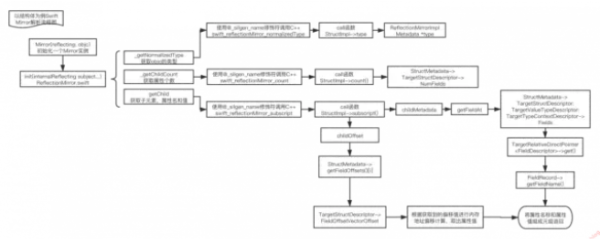
е…ідәҺе…¶д»–зұ»еһӢзҡ„еҸҚе°„д№ҹеӨ§еҗҢе°ҸејӮпјҢиҝҳжңүе…ғз»„гҖҒжһҡдёҫгҖҒзұ»гҖҒе…ғж•°жҚ®д»ҘеҸҠдёҚйҖҸжҳҺзұ»еһӢзҡ„еҸҚе°„пјҢеҪ“然д№ҹжңүдёҚе®Ңе…Ёж”ҜжҢҒеҸҚе°„зҡ„зұ»еһӢпјҢжҜ”еҰӮз»“жһ„дҪ“е°ұжҳҜдёҚе®Ңе…Ёж”ҜжҢҒеҸҚе°„зҡ„зұ»еһӢпјҢж„ҹе…ҙи¶Јзҡ„еҸҜд»Ҙ继з»ӯжҺўзҙўдёҖдёӢгҖӮ
swiftдёӯзҡ„type(of:)гҖҒdump(t)е°ұжҳҜеҹәдәҺMirrorзҡ„еҸҚе°„еҺҹзҗҶжқҘе®һзҺ°зҡ„
Swiftдёӯзҡ„jsonи§ЈжһҗжЎҶжһ¶HandyJSONзҡ„дё»иҰҒеҺҹзҗҶдёҺMirrorзұ»дјјпјҢжң¬иҙЁдёҠе°ұжҳҜеҲ©з”Ёmetadataдёӯзҡ„DescriptionпјҢйҖҡиҝҮеӯ—ж®өзҡ„и®ҝй—®пјҢеҒҡеҶ…еӯҳзҡ„иөӢеҖјгҖӮ
дёәдәҶеҠ ж·ұеҜ№Mirrorзҡ„зҗҶи§ЈпјҢжҲ‘们дҪҝз”ЁSwiftиҜӯиЁҖд»ҝеҶҷдёҖдёӢгҖӮиҝҳжҳҜд»Ҙз»“жһ„дҪ“дёәдҫӢгҖӮ
йҰ–е…ҲжҲ‘们йңҖиҰҒжӢҘжңүдёҖдёӘз»“жһ„дҪ“зҡ„е…ғж•°жҚ®з»“жһ„пјҢиҝҷйҮҢжҲ‘们е‘ҪеҗҚдёәStructMetadataпјҢйҮҢйқўжңү继жүҝзҡ„kindе’ҢDescriptorеұһжҖ§пјҢиҝҷйҮҢзҡ„DescriptorеұһжҖ§жҳҜдёҖдёӘTargetStructDescriptorзұ»еһӢзҡ„жҢҮй’ҲгҖӮд»ҝеҶҷд»Јз ҒеҰӮдёӢпјҡ
struct StructMetadata{ var kind: Int var Descriptor: UnsafeMutablePointer<StructDescriptor> }еңЁ4.1дёӯжҲ‘们用еҲ°зҡ„DescriptorеұһжҖ§зҡ„еҶ…йғЁз»“жһ„зҺ°еңЁд№ҹжқҘе®һзҺ°дёҖдёӢгҖӮиҝҷдёӘжҳҜMirrorдёӯз”ЁеҲ°еҫҲеӨҡзҡ„еұһжҖ§гҖӮеҜ№дәҺз»“жһ„дҪ“жқҘиҜҙе…¶еҶ…йғЁжңү7дёӘеұһжҖ§
йёҝи’ҷе®ҳж–№жҲҳз•ҘеҗҲдҪңе…ұе»әвҖ”вҖ”HarmonyOSжҠҖжңҜзӨҫеҢә
flagжҳҜдёӘ32дҪҚзҡ„ж•ҙеҪўпјҢжҲ‘们用Int32д»Јжӣҝ
parentжҳҜи®°еҪ•зҲ¶зұ»зҡ„пјҢзұ»еһӢжҳҜTargetRelativeContextPointer
nameи®°еҪ•зұ»еһӢзҡ„пјҢе®ғзҡ„зұ»еһӢжҳҜTargetRelativeDirectPointer
AccessFunctionPtrдёҺnameзұ»дјјпјҢеҶ…йғЁжҳҜдёӘжҢҮй’Ҳ
Fieldsд№ҹдёҺnameзұ»дјјпјҢеҶ…йғЁжҳҜдёӘFieldDescriptor
NumFieldsдҪҝз”ЁInt32
FieldOffsetVectorOffsetд№ҹжҳҜз”ЁInt32
д»ҝеҶҷе®һзҺ°еҰӮдёӢпјҡ
struct StructDescriptor { let flags: Int32 let parent: Int32 var name: RelativePointer<CChar> var AccessFunctionPtr: RelativePointer<UnsafeRawPointer> var Fields: RelativePointer<FieldDescriptor> var NumFields: Int32 var FieldOffsetVectorOffset: Int32 }TargetRelativeDirectPointerжҳҜRelativeDirectPointerзҡ„еҲ«еҗҚпјҢе…¶еҶ…йғЁжңүдёҖдёӘ继жүҝзҡ„RelativeOffsetеұһжҖ§пјҢжҳҜint32_tзұ»еһӢпјҢжҲ‘们еҸҜд»Ҙз”ЁInt32д»ЈжӣҝгҖӮ
иҝҳжңүдёҖдёӘgetж–№жі•гҖӮеҶ…йғЁйҖҡиҝҮжҢҮй’ҲеҒҸ移иҺ·еҸ–еҖј
д»ҝеҶҷе®һзҺ°еҰӮдёӢпјҡ
struct RelativePointer<T> { var offset: Int32 mutating func get() -> UnsafeMutablePointer<T>{ let offset = self.offset return withUnsafePointer(to: &self) { p in return UnsafeMutablePointer(mutating: UnsafeRawPointer(p).advanced(by: numericCast(offset)).assumingMemoryBound(to: T.self)) } } }FieldDescriptorеңЁMirrorеҸҚе°„дёӯжңүзқҖеҫҲйҮҚиҰҒзҡ„дҪңз”ЁпјҢе…¶еҶ…йғЁжңү5дёӘеұһжҖ§пјҡ
йёҝи’ҷе®ҳж–№жҲҳз•ҘеҗҲдҪңе…ұе»әвҖ”вҖ”HarmonyOSжҠҖжңҜзӨҫеҢә
MangledTypeNameжҳҜRelativeDirectPointer
SuperclassдёҺMangledTypeNameдёҖж ·
kindжҳҜFieldDescriptorKindзұ»еһӢпјҢе®һйҷ…жҳҜuint16_tпјҢиҝҷйҮҢжҲ‘们дҪҝз”ЁUInt16д»Јжӣҝ
fieldRecordSizeжҳҜuint16_tд№ҹдҪҝз”ЁдҪҝз”ЁUInt16д»Јжӣҝ
numFieldsдҪҝз”ЁInt32д»Јжӣҝ
fieldsпјҢе…¶е®һд»ҺеұһжҖ§дёҠзңӢдёҚеҲ°жңүиҝҷдёӘпјҢдҪҶжҳҜиҝҷйҮҢйқўжңүдёӘgetFieldRecordBufferж–№жі•пјҢйҖҡиҝҮthis+1зҡ„ж–№ејҸдёҖдёӘдёҖдёӘзҡ„и®ҝй—®еұһжҖ§пјҢжүҖд»ҘиҝҷжҳҜдёҖеқ—иҝһз»ӯзҡ„еҶ…еӯҳз©әй—ҙпјҢжҲ‘们дҪҝз”Ёfieldsд»Јжӣҝ
д»ҝеҶҷд»Јз ҒеҰӮдёӢпјҡ
struct FieldDescriptor { var MangledTypeName: RelativePointer<CChar> var Superclass: RelativePointer<CChar> var kind: UInt16 var fieldRecordSize: Int16 var numFields: Int32 var fields: FieldRecord //иҝһз»ӯзҡ„еӯҳеӮЁз©әй—ҙ }FieldRecordеӯҳеӮЁзқҖеұһжҖ§зҡ„зӣёе…ідҝЎжҒҜпјҢе…¶еҶ…йғЁжңүдёүдёӘеұһжҖ§
йёҝи’ҷе®ҳж–№жҲҳз•ҘеҗҲдҪңе…ұе»әвҖ”вҖ”HarmonyOSжҠҖжңҜзӨҫеҢә
FlagsжҳҜFieldRecordFlagsзұ»еһӢе®һйҷ…жҳҜuint32_tпјҢиҝҷйҮҢжҲ‘们дҪҝз”ЁInt32д»Јжӣҝ
MangledTypeNameдҪҝз”ЁRelativePointer
FieldNameдҪҝз”ЁRelativePointer
д»ҝеҶҷеёҰеҰӮдёӢпјҡ
struct FieldRecord { var Flags: Int32 var MangledTypeName: RelativePointer<CChar> var FieldName: RelativePointer<CChar> }дёӢйқўжҲ‘们дҪҝз”ЁеҶ…еӯҳз»‘е®ҡзҡ„и®Ўж•°и®ҝй—®дёҖдёӘз»“жһ„дҪ“
е®ҡд№үдёҖдёӘз»“жһ„дҪ“пјҡ
struct Person { var name: String = "xiaohei" var age: Int = 18 var height = 1.85 } var p = Person()дҪҝз”ЁunsafeBitCastжҢүдҪҚејәиҪ¬пјҢе°ҶPersonз»‘е®ҡеҲ°StructMetadataдёҠпјҢиҝҷдёӘж“ҚдҪңйқһеёёеҚұйҷ©пјҢжІЎжңүд»»дҪ•ж ЎйӘҢе’Ңдҝ®йҘ°
let ptr = unsafeBitCast(Person.self as Any.Type, to: UnsafeMutablePointer<StructMetadata>.self)
дёӢйқўжҲ‘们е°ұжү“еҚ°дёҖдёӢз»“жһ„дҪ“зҡ„зұ»еһӢ(д№ҹе°ұжҳҜе®ғзҡ„еҗҚз§°)е’Ңе…¶дёӯеұһжҖ§зҡ„дёӘж•°пјҡ
let namePtr = ptr.pointee.Descriptor.pointee.name.get() print(String(cString: namePtr)) print(ptr.pointee.Descriptor.pointee.NumFields)
жү“еҚ°з»“жһңпјҡ
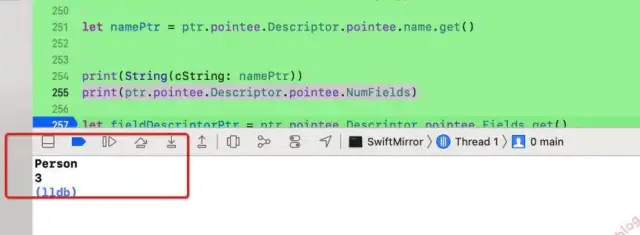
иҝҷйҮҢжҲ‘们е°ұеҸҜд»ҘзңӢеҲ°з»“жһ„дҪ“зҡ„еҗҚз§°е’Ңе…¶еұһжҖ§дёӘж•°зҡ„жӯЈзЎ®жү“еҚ°дәҶгҖӮ
дёӢйқўжҲ‘们е°ұжқҘжү“еҚ°дёҖдёӢеұһжҖ§зҡ„еҗҚз§°пјҢйҰ–е…ҲжҳҜиҺ·еҸ–еҲ°FieldDescriptorзҡ„жҢҮй’ҲпјҢ然еҗҺйҖҡиҝҮеҶ…еӯҳеҒҸ移зҡ„ж–№ејҸи®ҝй—®жҜҸдёҖдёӘFieldRecordпјҢжңҖеҗҺеңЁи®ҝй—®FieldRecordдёӯзҡ„еұһжҖ§еҗҚгҖӮд»Јз ҒеҰӮдёӢпјҡ
let fieldDescriptorPtr = ptr.pointee.Descriptor.pointee.Fields.get() let recordPtr = withUnsafePointer(to: &fieldDescriptorPtr.pointee.fields) { return UnsafeMutablePointer(mutating: UnsafeRawPointer($0).assumingMemoryBound(to: FieldRecord.self).advanced(by: 2)) } print(String(cString: recordPtr.pointee.FieldName.get()))жү“еҚ°з»“жһңпјҡ

жӯӨж—¶жҲ‘们е°ұеҸҜд»ҘзңӢеҲ°з¬¬дёүеұһжҖ§heightзҡ„жү“еҚ°пјҢеҰӮжһңadvanced(by: 0)еҲҷжү“еҚ°з¬¬дёҖдёӘеұһжҖ§пјҢд»ҘжӯӨзұ»жҺЁгҖӮ

дёӢйқўжҲ‘们и®ҝй—®дёҖдёӢеұһжҖ§еҖјпјҡ
йҰ–е…ҲжҳҜиҺ·еҸ–еұһжҖ§еҒҸ移йҮҸзҡ„ж•°з»„пјҢд№ҹе°ұжҳҜgetFieldOffsetsеҮҪж•°иҝ”еӣһзҡ„еҖјгҖӮж №жҚ®жәҗз Ғ:
йҰ–е…ҲиҺ·еҸ–FieldOffsetVectorOffsetзҡ„еҖј
然еҗҺеңЁеҠ дёҠthisд№ҹе°ұжҳҜеҪ“еүҚMetadataзҡ„жҢҮй’Ҳ
иҝҷйҮҢжҲ‘们е°Ҷд»ҝеҶҷзҡ„StructMetadataзҡ„жҢҮй’ҲptrйҮҚз»‘е®ҡдёәInt
жәҗз ҒдёӯеҠ дёҠFieldOffsetVectorOffsetпјҢиҝҷйҮҢжҲ‘们е°ұ移еҠЁFieldOffsetVectorOffset
然еҗҺе°ҶдёҠиҝ°з§»еҠЁеҗҺзҡ„з»‘е®ҡдёәдёҖдёӘInt32зҡ„жҢҮй’Ҳ
жңҖеҗҺдҪҝз”ЁUnsafeBufferPointerе’ҢеұһжҖ§дёӘж•°еҲӣе»әдёҖдёӘbufferж•°з»„жҢҮй’Ҳ
жҺҘдёӢжқҘжҲ‘们е°ұеҸҜд»Ҙд»Һж•°з»„дёӯеҸ–еҮәжҜҸдёӘеұһжҖ§зҡ„еҒҸ移еҖј
然еҗҺеҸ–еҮәз»“жһ„дҪ“е®һдҫӢpзҡ„еҶ…еӯҳең°еқҖ
然еҗҺжҢүз…§bufferж•°з»„дёӯзҡ„еҒҸ移еҖјиҝӣиЎҢеҒҸ移пјҢйҮҚз»‘е®ҡдёәеұһжҖ§зҡ„зұ»еһӢ
жңҖеҗҺе°ұеҸҜд»Ҙжү“еҚ°еҮәеұһжҖ§еҖјдәҶ
е®һзҺ°д»Јз Ғпјҡ
var bufferPtr = UnsafeBufferPointer(start: UnsafeRawPointer(UnsafeRawPointer(ptr).assumingMemoryBound(to: Int.self).advanced(by: numericCast(ptr.pointee.Descriptor.pointee.FieldOffsetVectorOffset))).assumingMemoryBound(to: Int32.self), count: Int(ptr.pointee.Descriptor.pointee.NumFields)) var fieldOffset = bufferPtr[2] var valuePtr = withUnsafeMutablePointer(to: &p) { $0 } var bufferPtr1 = UnsafeRawPointer(UnsafeRawPointer(valuePtr).advanced(by: numericCast(bufferPtr[0]))).assumingMemoryBound(to: String.self) print(bufferPtr1.pointee) var bufferPtr2 = UnsafeRawPointer(UnsafeRawPointer(valuePtr).advanced(by: numericCast(bufferPtr[1]))).assumingMemoryBound(to: Int.self) print(bufferPtr2.pointee) var bufferPtr3 = UnsafeRawPointer(UnsafeRawPointer(valuePtr).advanced(by: numericCast(bufferPtr[2]))).assumingMemoryBound(to: Double.self) print(bufferPtr3.pointee)жү“еҚ°з»“жһңпјҡ
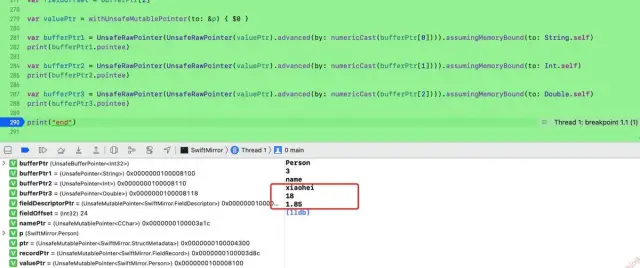
д»ҘдёҠжҳҜвҖңSwiftдёӯеҸҚе°„MirrorжҖҺд№Ҳз”ЁвҖқиҝҷзҜҮж–Үз« зҡ„жүҖжңүеҶ…е®№пјҢж„ҹи°ўеҗ„дҪҚзҡ„йҳ…иҜ»пјҒзӣёдҝЎеӨ§е®¶йғҪжңүдәҶдёҖе®ҡзҡ„дәҶи§ЈпјҢеёҢжңӣеҲҶдә«зҡ„еҶ…е®№еҜ№еӨ§е®¶жңүжүҖеё®еҠ©пјҢеҰӮжһңиҝҳжғіеӯҰд№ жӣҙеӨҡзҹҘиҜҶпјҢж¬ўиҝҺе…іжіЁдәҝйҖҹдә‘иЎҢдёҡиө„и®Ҝйў‘йҒ“пјҒ
е…ҚиҙЈеЈ°жҳҺпјҡжң¬з«ҷеҸ‘еёғзҡ„еҶ…е®№пјҲеӣҫзүҮгҖҒи§Ҷйў‘е’Ңж–Үеӯ—пјүд»ҘеҺҹеҲӣгҖҒиҪ¬иҪҪе’ҢеҲҶдә«дёәдё»пјҢж–Үз« и§ӮзӮ№дёҚд»ЈиЎЁжң¬зҪ‘з«ҷз«ӢеңәпјҢеҰӮжһңж¶үеҸҠдҫөжқғиҜ·иҒ”зі»з«ҷй•ҝйӮ®з®ұпјҡis@yisu.comиҝӣиЎҢдёҫжҠҘпјҢ并жҸҗдҫӣзӣёе…іиҜҒжҚ®пјҢдёҖз»ҸжҹҘе®һпјҢе°Ҷз«ӢеҲ»еҲ йҷӨж¶үе«ҢдҫөжқғеҶ…е®№гҖӮ